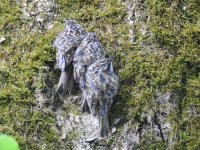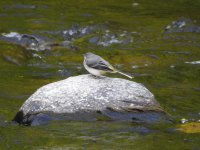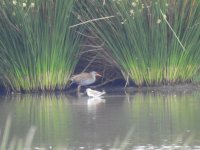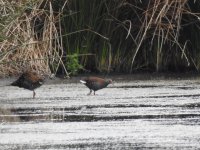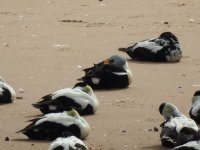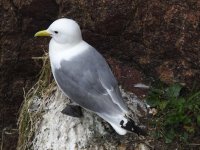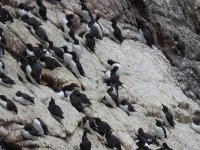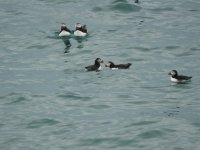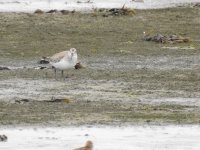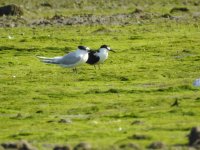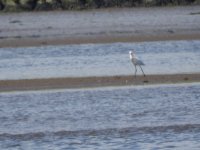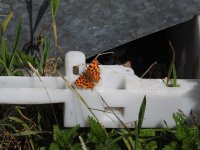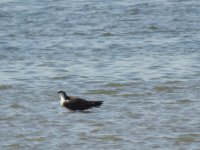-
Welcome to BirdForum, the internet's largest birding community with thousands of members from all over the world. The forums are dedicated to wild birds, birding, binoculars and equipment and all that goes with it.
Please register for an account to take part in the discussions in the forum, post your pictures in the gallery and more.
You are using an out of date browser. It may not display this or other websites correctly.
You should upgrade or use an alternative browser.
You should upgrade or use an alternative browser.
Tayforth Birding (11 Viewers)
- Thread starter delia todd
- Start date
More options
Who Replied?Nicola Main
Well-known member
Hi kawwauser I disagree with you Andrew sorry I think the warbler is a Lesser Whitethroat. I can't put my finger on it but it just looks more like a Lesser than a Common. I could be wrong though! 

Hi kawwauser I disagree with you Andrew sorry I think the warbler is a Lesser Whitethroat. I can't put my finger on it but it just looks more like a Lesser than a Common. I could be wrong though!
It looks darker than usual but that's just the light. The angle also means you can't see the rufous in the wings because they're in shadow. It has quite bright orange-pink legs however, which are right for Common Whitethroat but wrong for Lesser, which has dark grey or blackish legs.
Last edited:
Another Wednesday Wandering
Having returned on Tuesday from my latest offshore sojourn, I was keen yesterday, to get out and find some birds. I made contact with Stonefaction (Barry), as I made my way home from Aberdeen on the train, and we soon had an arrangement to meet up mid-morning the next day. We had both seen text alerts of R-B Shrike at Kilminning/Balcomie that day (Tues), so that seemed to be the place to head for.
I was on the road by 06:00 hrs, driving north through thick fog. Barry wasn't able to get to out meet place at the Eden Estuary Centre (EEC) until ten-nish, so my plan was to spend some time at the Ladybank area hotspots, until I had to head for the EEC.
Letham Pools was my first call. There had been reports of a drake Garganey being there up until the weekend. I had a faint hope that the bird had not yet moved on. As I peered out over the fog blanketed waters of the pools, I quickly realised that if they were more than halfway across the main pool, there could be a Garganey convention, with full Garganey parade, and I would never know it.
I spent an hour patrolling up and down the road that intersects the pools. No Garganey, but plenty of other birds in sight. Sand Martins were calling as they swept through the mists, while the background noise was dominated by Black-headed Gulls from the reedy island that lay unseen on the far side.
I moved on to Mountcastle after about an hour. The main target here was Garden Warbler; several having been there last year. As I made my way along the track, I heard what I believe was a Garden Warbler, but the trees have a lot more leaves on than they did three weeks ago, and I was not able to locate the vocalist. I made my way along the tree fringed track, finding Willow Warbler and Chiffchaff, but no further sign of the sought after Garden Warbler. Making my way back towards where I thought I had heard the GW originally, I heard another bird singing. I headed into the undergrowth again; listening, then creeping a few steps towards the sound, then listening again and repeating the process.
I was approaching the waters edge, when a burst of song quite close to me enable me to visually detect some movement in a particularly leafy tree. Intensive scanning with the binoculars eventually gave me a good view of a male Blackcap.
I may have been incorrect on thinking that the original son was from a Garden Warbler, and maybe it was a Blackcap. I'm not great on birdsong, but I still think there was a GW in there somewhere.
The sun had broken through now, so I headed back to the Letham Pools. There was no Garganey convention in sight, even though I could fairly clearly see the far bank. I'd missed the parade, so quickly moved on.
I soon arrived at a sunshine bathed Wilderness. Scanning from the roadside wall, I soon picked out some distant waders. I quick dash for and rig up of the scope, soon revealed about half a dozen Black-Tailed Godwits.
Godwits aside, the Wilderness was pretty quiet, so I decided to head early for the EEC. Entering the centre, I found the tide was way out, but the mudflats were mostly deserted of waders, apart from a handful of Oystercatchers. When Barry joined me after ten, we were soon on our way to Kilminning.
Parking up at Kilminning, we walked out to the walled garden, but were disappointed, if not unsurprised, not to find any of the previous day's reported R-B Shrike. It was the same story when we searched the overgrown garden of the farm and the top end of Kilminning. It was at this point that Barry suggested a bit of sea watching down at Fife Ness. This proved to be a very good move.
It was well past midday when we entered the FBC hide at Fife Ness. Settling in we soon had the more common seabirds that you would expect, but it was not long before Barry picked out a passing R-T Diver. Soon after this, and Barry again picked out something different. This time it was what was essentially a lifer for me; in the shape of two Manx Shearwaters.
Prior to me becoming involved in serious birding, I had noticed the odd shearwater while working offshore in the last twenty five years, but had never been motivated in identifying them exactly. I suspect some of those shearwaters were probably Manx. Strangely, the only shearwater I have seen and identified exactly while offshore, has been the much scarcer Balearic, a bird I had good views of last year.
I can't remember the order the birds came in, but there were a few more R-T Divers seen, and several more Manx Shearwaters. It was while I was focused on a distant group of Arctic Terns, that Barry announced the arrival of another passing diver. The bird actually flew straight through my field of scope vision, without me coming off the tern group. I had assumed that it would be another Red-Throated Diver, but examination of Barry's photos showed a Black-Throated Diver. A fourth year tick of the day for me joining the Manx Shearwater, Arctic Terns and a Corn Bunting that we had spotted from the car on the way out of Crail.
It was as I was packing up the scope, that my fifth year tick of the day showed up. Barry called Skua, and grabbing the binoculars, I was soon on a passing Arctic Skua.
Leaving Fife Ness, we made a brief call at the lower end of Kilminning before trying for Yellow Wagtails just outside Crail. Yellow Wagtail is the bird that I spent the most time and effort looking for without success. In that sense it is my current bogie bird (I don't believe in luck). It is still my bogie bird, as yesterdays search in the area it is known to frequent proved fruitless.
From Crail we went to Kilrenny where we searched the woodland area before calling it a day. I dropped Barry off at the bus stop and headed home with a total of eighty one species of bird seen. That is something like eight times the total of species seen by me in the previous three offshore weeks, so all in all, a very good day. :t:
Having returned on Tuesday from my latest offshore sojourn, I was keen yesterday, to get out and find some birds. I made contact with Stonefaction (Barry), as I made my way home from Aberdeen on the train, and we soon had an arrangement to meet up mid-morning the next day. We had both seen text alerts of R-B Shrike at Kilminning/Balcomie that day (Tues), so that seemed to be the place to head for.
I was on the road by 06:00 hrs, driving north through thick fog. Barry wasn't able to get to out meet place at the Eden Estuary Centre (EEC) until ten-nish, so my plan was to spend some time at the Ladybank area hotspots, until I had to head for the EEC.
Letham Pools was my first call. There had been reports of a drake Garganey being there up until the weekend. I had a faint hope that the bird had not yet moved on. As I peered out over the fog blanketed waters of the pools, I quickly realised that if they were more than halfway across the main pool, there could be a Garganey convention, with full Garganey parade, and I would never know it.
I spent an hour patrolling up and down the road that intersects the pools. No Garganey, but plenty of other birds in sight. Sand Martins were calling as they swept through the mists, while the background noise was dominated by Black-headed Gulls from the reedy island that lay unseen on the far side.
I moved on to Mountcastle after about an hour. The main target here was Garden Warbler; several having been there last year. As I made my way along the track, I heard what I believe was a Garden Warbler, but the trees have a lot more leaves on than they did three weeks ago, and I was not able to locate the vocalist. I made my way along the tree fringed track, finding Willow Warbler and Chiffchaff, but no further sign of the sought after Garden Warbler. Making my way back towards where I thought I had heard the GW originally, I heard another bird singing. I headed into the undergrowth again; listening, then creeping a few steps towards the sound, then listening again and repeating the process.
I was approaching the waters edge, when a burst of song quite close to me enable me to visually detect some movement in a particularly leafy tree. Intensive scanning with the binoculars eventually gave me a good view of a male Blackcap.
I may have been incorrect on thinking that the original son was from a Garden Warbler, and maybe it was a Blackcap. I'm not great on birdsong, but I still think there was a GW in there somewhere.
The sun had broken through now, so I headed back to the Letham Pools. There was no Garganey convention in sight, even though I could fairly clearly see the far bank. I'd missed the parade, so quickly moved on.
I soon arrived at a sunshine bathed Wilderness. Scanning from the roadside wall, I soon picked out some distant waders. I quick dash for and rig up of the scope, soon revealed about half a dozen Black-Tailed Godwits.
Godwits aside, the Wilderness was pretty quiet, so I decided to head early for the EEC. Entering the centre, I found the tide was way out, but the mudflats were mostly deserted of waders, apart from a handful of Oystercatchers. When Barry joined me after ten, we were soon on our way to Kilminning.
Parking up at Kilminning, we walked out to the walled garden, but were disappointed, if not unsurprised, not to find any of the previous day's reported R-B Shrike. It was the same story when we searched the overgrown garden of the farm and the top end of Kilminning. It was at this point that Barry suggested a bit of sea watching down at Fife Ness. This proved to be a very good move.
It was well past midday when we entered the FBC hide at Fife Ness. Settling in we soon had the more common seabirds that you would expect, but it was not long before Barry picked out a passing R-T Diver. Soon after this, and Barry again picked out something different. This time it was what was essentially a lifer for me; in the shape of two Manx Shearwaters.
Prior to me becoming involved in serious birding, I had noticed the odd shearwater while working offshore in the last twenty five years, but had never been motivated in identifying them exactly. I suspect some of those shearwaters were probably Manx. Strangely, the only shearwater I have seen and identified exactly while offshore, has been the much scarcer Balearic, a bird I had good views of last year.
I can't remember the order the birds came in, but there were a few more R-T Divers seen, and several more Manx Shearwaters. It was while I was focused on a distant group of Arctic Terns, that Barry announced the arrival of another passing diver. The bird actually flew straight through my field of scope vision, without me coming off the tern group. I had assumed that it would be another Red-Throated Diver, but examination of Barry's photos showed a Black-Throated Diver. A fourth year tick of the day for me joining the Manx Shearwater, Arctic Terns and a Corn Bunting that we had spotted from the car on the way out of Crail.
It was as I was packing up the scope, that my fifth year tick of the day showed up. Barry called Skua, and grabbing the binoculars, I was soon on a passing Arctic Skua.
Leaving Fife Ness, we made a brief call at the lower end of Kilminning before trying for Yellow Wagtails just outside Crail. Yellow Wagtail is the bird that I spent the most time and effort looking for without success. In that sense it is my current bogie bird (I don't believe in luck). It is still my bogie bird, as yesterdays search in the area it is known to frequent proved fruitless.
From Crail we went to Kilrenny where we searched the woodland area before calling it a day. I dropped Barry off at the bus stop and headed home with a total of eighty one species of bird seen. That is something like eight times the total of species seen by me in the previous three offshore weeks, so all in all, a very good day. :t:
Last edited:
Stonefaction
Dundee Birding....(target 150 in 2024).

My take on Wednesday's day out in Fife with Paul (Gander), including photos...
https://stonefactionbirding2014.blogspot.com/2018/05/shrike-it-lucky-30518.html
https://stonefactionbirding2014.blogspot.com/2018/05/shrike-it-lucky-30518.html
Wednesday Wanderings in Perthshire
It was after nine when I picked up Barry in Dundee. This weeks plan was a wander around some of the Perthshire glens. As Barry was doing the navigating, I'd supplied him with a list of birds missing off my year list. Mainly raptors, the list also included Spotted Flycatcher.
I had headed out at about half past seven. As I made my way across Fife, I firstly dropped in at the Wilderness, and then at Letham Pools. The main target at Letham was Water Rail, as it had been on several occasions this week, but once again they evaded me.
I arrived at the Tay Bridge car park on the Fife side at about 08:45 hrs. The plan was to wait there for half an hour or so until Barry, who had an appointment, phoned for me to pop over the bridge and pick him up. Waiting in the tree surrounded car park, I decided to have a little wander here. I was soon spotting birds, the best of which was a Sparrowhawk that flew by with its breakfast dangling from its talons. I'd already spotted a bacon roll at the car park hot food kiosk prior to seeing the hawk. The roll had met a similar fate to whatever poor little bird the hawk had pounced on.
It was not too long later that I received a text from Barry, and minutes later he was clambering into the car and we were off. in the direction of Perthshire. The sun was shining, and I had a good feeling about the day ahead.
I am going to be a little vague about where exactly we were for two reasons. Reason one is the sensitivity of some of the birds spotted. Reason two is that I wasn't exactly sure of where I was half the time.
Under Barry's guidance, we reached the beginning of our first target glen and started up it. Every now and again, we'd stop the car in a suitable(ish) place and have a scan about the area. This was a pattern that we followed all day, hardly ever being more than a few seconds away from the car.
It was during one of these stops that we picked up my first year tick of the day, as a Cuckoo swept in towards our position, then away again. Barry was equally delighted at this stop, when he picked up on a lifer for him. Not a bird, but a Golden Ringed Dragonfly.
We proceeded to the top of this first glen before turning back at the loch that sits near its head. As we headed back down the road, a pair of Whinchats were seen on a roadside boulder. We moved on quickly, as the male had a beak full of food, and was obviously waiting to head in to what we guessed was a nearby nest. Whinchat though was year tick number two for me.
Instead of heading all the way back down the glen, we turned off onto a smaller winding road that crossed the hills. I can't remember us spotting too much along this road, and we were soon descending down onto a main road that took us along side a large loch to a village. Passing through the village we again turned off the main road and started to climb up a particularly steep road that ascended up and over the hill that overlooked the village below.
At the top of the climb, we started to stop and scan again, as we moved our way along this new glen. The surroundings here were typical Scottish moorland, so with raptors high on the agenda, we paid particular attention to the hilltops and skyline. We soon started picking out distant raptors at several of our stops. Although distant, some still looked large. Barry clicked away with his camera and zoom lens, and the display confirmed that we had found eagles. Now the question is what type? Golden Eagle was the most likely for the location, but White-tailed was not impossible. We needed to wait for Barry to be able to check the photos on a full size computer screen before confirming what will be a lifer for me if Golden can be confirmed.
Moving on we were at one of our scanning spots when Barry said something along the lines of, " It's quiet here, so I'm going to take a leak". He then disappeared behind a heap of roadside rubble to answer the call of nature. Of course, he has hardly gone ten seconds when I spotted a raptor relatively close to us and getting closer. I shouted raptor in the direction of the unseen Barry, while continuing to keep it in view through the binoculars, until Barry was able to join me again.
I could tell the bird was not an Eagle or a Buzzard. Hen Harrier was a considered possibility, but as it wheeled closer to us, I stated that I thought it may be a Red Kite. Barry soon had the big lens on the bird, and confirmed Red Kite, giving me my third year tick of the day. I requested that Barry take more comfort breaks, as this seemed to have triggered greater success.
Moving on a little way, we found more Red Kites, having four in view at one time, at one point. It was here that we also found a pair of Kestrels chasing after each other.
All too soon we were heading out of this glen. As we did so, we passed through an area known to be holding Short-eared Owls. We saw a couple of other birders/photographers parked up at different points, obviously waiting for the owls to make an appearance in the fields that fell away below the road. Barry advised that to stop and chat to these other birders would create a bit of crowding that might put the owls off, so we just headed on.
We were only seconds past the second parked up birder, when a Short-eared Owl swept along the roadside ahead of us. It banked away and down onto the fields where it quartered in a hunting pattern. We stopped very briefly to allow Barry to grab some photos out of the passenger window, before moving on so as not to cause any disturbance to this bird or its hidden partner.
The Short-eared owl was our unanimous bird of the day award winner, and a fourth confirmed year tick for me.
After exiting the glen, we decided on an impromptu visit to Loch of Lowes. The centre was closing up as we arrived, but we managed a quick viewing of the Ospreys, but did not find the Mandarin Duck that is in the area. From Loch of Lowes, we headed across to Blairgowrie, where we stopped for a while at the riverside. It was here we picked up on Dipper, and a pair of Grey Wagtails feeding their fledged youngsters that stood on the tops of river surrounded rocks. It was also here that Barry's keen ears picked up the sound of young birds in a riverbank tree. He soon located three young fledged Treecreepers, huddled together in a slight depression of a moss covered tree trunk. (see photo). The parents were nearby, still bringing food in for their charges.
It was here the birding day ended. I dropped Barry off in Dundee and headed home, with only the briefest of stops at Letham Pools to check for Water Rail. There were no Water Rail in sight, but I can't really complain on a day like today, even though Spotted Flycatcher also evaded us. Seventy-four species seen, including seven raptors (Sparrowhawk, Buzzard, Kestrel, Red Kite, Eagle, S-E Owl, Osprey).
It was after nine when I picked up Barry in Dundee. This weeks plan was a wander around some of the Perthshire glens. As Barry was doing the navigating, I'd supplied him with a list of birds missing off my year list. Mainly raptors, the list also included Spotted Flycatcher.
I had headed out at about half past seven. As I made my way across Fife, I firstly dropped in at the Wilderness, and then at Letham Pools. The main target at Letham was Water Rail, as it had been on several occasions this week, but once again they evaded me.
I arrived at the Tay Bridge car park on the Fife side at about 08:45 hrs. The plan was to wait there for half an hour or so until Barry, who had an appointment, phoned for me to pop over the bridge and pick him up. Waiting in the tree surrounded car park, I decided to have a little wander here. I was soon spotting birds, the best of which was a Sparrowhawk that flew by with its breakfast dangling from its talons. I'd already spotted a bacon roll at the car park hot food kiosk prior to seeing the hawk. The roll had met a similar fate to whatever poor little bird the hawk had pounced on.
It was not too long later that I received a text from Barry, and minutes later he was clambering into the car and we were off. in the direction of Perthshire. The sun was shining, and I had a good feeling about the day ahead.
I am going to be a little vague about where exactly we were for two reasons. Reason one is the sensitivity of some of the birds spotted. Reason two is that I wasn't exactly sure of where I was half the time.
Under Barry's guidance, we reached the beginning of our first target glen and started up it. Every now and again, we'd stop the car in a suitable(ish) place and have a scan about the area. This was a pattern that we followed all day, hardly ever being more than a few seconds away from the car.
It was during one of these stops that we picked up my first year tick of the day, as a Cuckoo swept in towards our position, then away again. Barry was equally delighted at this stop, when he picked up on a lifer for him. Not a bird, but a Golden Ringed Dragonfly.
We proceeded to the top of this first glen before turning back at the loch that sits near its head. As we headed back down the road, a pair of Whinchats were seen on a roadside boulder. We moved on quickly, as the male had a beak full of food, and was obviously waiting to head in to what we guessed was a nearby nest. Whinchat though was year tick number two for me.
Instead of heading all the way back down the glen, we turned off onto a smaller winding road that crossed the hills. I can't remember us spotting too much along this road, and we were soon descending down onto a main road that took us along side a large loch to a village. Passing through the village we again turned off the main road and started to climb up a particularly steep road that ascended up and over the hill that overlooked the village below.
At the top of the climb, we started to stop and scan again, as we moved our way along this new glen. The surroundings here were typical Scottish moorland, so with raptors high on the agenda, we paid particular attention to the hilltops and skyline. We soon started picking out distant raptors at several of our stops. Although distant, some still looked large. Barry clicked away with his camera and zoom lens, and the display confirmed that we had found eagles. Now the question is what type? Golden Eagle was the most likely for the location, but White-tailed was not impossible. We needed to wait for Barry to be able to check the photos on a full size computer screen before confirming what will be a lifer for me if Golden can be confirmed.
Moving on we were at one of our scanning spots when Barry said something along the lines of, " It's quiet here, so I'm going to take a leak". He then disappeared behind a heap of roadside rubble to answer the call of nature. Of course, he has hardly gone ten seconds when I spotted a raptor relatively close to us and getting closer. I shouted raptor in the direction of the unseen Barry, while continuing to keep it in view through the binoculars, until Barry was able to join me again.
I could tell the bird was not an Eagle or a Buzzard. Hen Harrier was a considered possibility, but as it wheeled closer to us, I stated that I thought it may be a Red Kite. Barry soon had the big lens on the bird, and confirmed Red Kite, giving me my third year tick of the day. I requested that Barry take more comfort breaks, as this seemed to have triggered greater success.
Moving on a little way, we found more Red Kites, having four in view at one time, at one point. It was here that we also found a pair of Kestrels chasing after each other.
All too soon we were heading out of this glen. As we did so, we passed through an area known to be holding Short-eared Owls. We saw a couple of other birders/photographers parked up at different points, obviously waiting for the owls to make an appearance in the fields that fell away below the road. Barry advised that to stop and chat to these other birders would create a bit of crowding that might put the owls off, so we just headed on.
We were only seconds past the second parked up birder, when a Short-eared Owl swept along the roadside ahead of us. It banked away and down onto the fields where it quartered in a hunting pattern. We stopped very briefly to allow Barry to grab some photos out of the passenger window, before moving on so as not to cause any disturbance to this bird or its hidden partner.
The Short-eared owl was our unanimous bird of the day award winner, and a fourth confirmed year tick for me.
After exiting the glen, we decided on an impromptu visit to Loch of Lowes. The centre was closing up as we arrived, but we managed a quick viewing of the Ospreys, but did not find the Mandarin Duck that is in the area. From Loch of Lowes, we headed across to Blairgowrie, where we stopped for a while at the riverside. It was here we picked up on Dipper, and a pair of Grey Wagtails feeding their fledged youngsters that stood on the tops of river surrounded rocks. It was also here that Barry's keen ears picked up the sound of young birds in a riverbank tree. He soon located three young fledged Treecreepers, huddled together in a slight depression of a moss covered tree trunk. (see photo). The parents were nearby, still bringing food in for their charges.
It was here the birding day ended. I dropped Barry off in Dundee and headed home, with only the briefest of stops at Letham Pools to check for Water Rail. There were no Water Rail in sight, but I can't really complain on a day like today, even though Spotted Flycatcher also evaded us. Seventy-four species seen, including seven raptors (Sparrowhawk, Buzzard, Kestrel, Red Kite, Eagle, S-E Owl, Osprey).
Attachments
Last edited:
Barry clicked away with his camera and zoom lens, and the display confirmed that we had found eagles. Now the question is what type? Golden Eagle was the most likely for the location, but White-tailed was not impossible. We needed to wait for Barry to be able to check the photos on a full size computer screen before confirming what will be a lifer for me if Golden can be confirmed.
With the photos now duly scrutinised, the jury has returned a verdict of W-T Eagles.

We will be visiting Rosyth, Scotland on August 3-4 via cruise ship. Any tips on birding the area would be appreciated. The cruise is timed to coincide with the Royal Edinburgh Military Tattoo, but I think we'd rather go birding if we can.
Thanks in advance.
Thanks in advance.

Royal Edinburgh Military Tattoo, but I think we'd rather go birding if we can.
Don't blame you Joe
Are you planning to hire a car? Otherwise I hope someone with transport can help you out. Sadly I'll be away at that time, otherwise I'd have loved to meet you.
Thanks much! Do you know if Uber or Lyft operate in the area and can get us to Loch Leven?
Uber operate in Edinburgh, but I have no idea if that means they would cover Rosyth to Loch Leven. I've not heard off Lyft, and don't think they operate in the Uk.
There will be private hire taxi companies available. I had a quick Google, and you are talking £30 - £40 one way. The other option is that there is a regular bus link from Rosyth to Kinross. Kinross is about 5km from the RSPB centre at Vane Farm. You can do this by taxi from Kinross or by bus, although the bus route looks a little convoluted, taking 23 mins. The other option is to walk along the Loch Leven Heritage trail. This is a really scenic walk, on a fairly flat trail. You would be sure to get some birds on the way.
Sorry I can't be of any greater help.

I'd never heard of Uber of Lyft before Joe, so don't know anything about them.
This is the usual site I use when looking up travel: Traveline Scotland, which hopefully will go directly to a bus leaving Rosyth about 9.15 am on the Friday.
A change (no walking involved there) at Dunfermline for the Perth bus, stopping at Kinross, journey in all takes about an hour. Costing just a few pounds.
This is a map showing Kinross and the southern end of the loch. The Heritage trail goes all the way round.
Vane Farm is just off the bottom right (you can scroll to see it). Virtually the whole of the lake is now a nature reserve and the island just off shore is where Mary Queen of Scots was imprisoned. There's boat rides out there if you want (you may get some close views of some birds too, doing that).
If you walk northwards, there is (or was) a hide along there, which the last time I visited overlooked a reed bed. Perhaps someone can confirm that.
Shame you can't ask the captain to delay your visit for a couple of weeks, when both Paul and I would be around LOL.
This is the usual site I use when looking up travel: Traveline Scotland, which hopefully will go directly to a bus leaving Rosyth about 9.15 am on the Friday.
A change (no walking involved there) at Dunfermline for the Perth bus, stopping at Kinross, journey in all takes about an hour. Costing just a few pounds.
This is a map showing Kinross and the southern end of the loch. The Heritage trail goes all the way round.
Vane Farm is just off the bottom right (you can scroll to see it). Virtually the whole of the lake is now a nature reserve and the island just off shore is where Mary Queen of Scots was imprisoned. There's boat rides out there if you want (you may get some close views of some birds too, doing that).
If you walk northwards, there is (or was) a hide along there, which the last time I visited overlooked a reed bed. Perhaps someone can confirm that.
Shame you can't ask the captain to delay your visit for a couple of weeks, when both Paul and I would be around LOL.
Mark Tulley
Member
Walk from Rosyth
Joe, if you like walking, the Fife Coastal Path goes through Rosyth. You could walk either direction along it for some easy birding. It is waymarked, good surface. It may be a bit urban near Rosyth. Depends how far you can walk.
Joe, if you like walking, the Fife Coastal Path goes through Rosyth. You could walk either direction along it for some easy birding. It is waymarked, good surface. It may be a bit urban near Rosyth. Depends how far you can walk.

LOL K!!! I'm the last to have heard of, or used, a lot of things you know!
But, amazingly, I have now got a couple of apps on my phone. One of which is the Collins Bird Guide!! But I'm still PAYG, don't want to get involved in a contract.
But, amazingly, I have now got a couple of apps on my phone. One of which is the Collins Bird Guide!! But I'm still PAYG, don't want to get involved in a contract.
Photo Bombed
I managed to grab half an hour at Letham Pools this afternoon, with Water Rail high on the agenda. I'd made several call ins at the pools over the last few weeks looking for Water Rail, but there had been no sign, so I wasn't very confident.
Parking up at the pools, I started scanning the small pool that is connected by a short channel to the large northern pool. Very quickly, I picked up on a bird wading in the reedy fringes. Certainly no Water Rail, but I was thinking one of the sandpipers maybe.
The bird was to far away for an ID with the 10x binoculars, so I grabbed the camera, zoomed in and started taking shots. I still couldn't make out enough of the bird to make an ID, so I kept clicking away to make sure I had enough detail to confirm whatever it was later.
It was while I was clicking away at the wader, that out of nowhere, and in a casual manner, a Water Rail photo bombed the little wader by walking straight through the shot (Photo 1). All that time chasing Water Rail, and all I had to do was point the camera at something else. The something else turned out to be an unseasonal Dunlin.
I took the camera off the birds briefly, but when I focused back in, the Water Rail was gone. I did not see where it had come from, or where it went too. A little later, I changed position to view the main north pool. From my new position, looking back towards the small pool, I of course found more Water Rail. There were two (Photo 2) in a quiet corner having a splashy wash and brush up. It is possible that one of them might have been the originally sighted rail. I also got a glimpse of what looked like another rail disappearing into the reeds, but am not 100% sure. There could be four birds there, but certainly two.
I managed to grab half an hour at Letham Pools this afternoon, with Water Rail high on the agenda. I'd made several call ins at the pools over the last few weeks looking for Water Rail, but there had been no sign, so I wasn't very confident.
Parking up at the pools, I started scanning the small pool that is connected by a short channel to the large northern pool. Very quickly, I picked up on a bird wading in the reedy fringes. Certainly no Water Rail, but I was thinking one of the sandpipers maybe.
The bird was to far away for an ID with the 10x binoculars, so I grabbed the camera, zoomed in and started taking shots. I still couldn't make out enough of the bird to make an ID, so I kept clicking away to make sure I had enough detail to confirm whatever it was later.
It was while I was clicking away at the wader, that out of nowhere, and in a casual manner, a Water Rail photo bombed the little wader by walking straight through the shot (Photo 1). All that time chasing Water Rail, and all I had to do was point the camera at something else. The something else turned out to be an unseasonal Dunlin.
I took the camera off the birds briefly, but when I focused back in, the Water Rail was gone. I did not see where it had come from, or where it went too. A little later, I changed position to view the main north pool. From my new position, looking back towards the small pool, I of course found more Water Rail. There were two (Photo 2) in a quiet corner having a splashy wash and brush up. It is possible that one of them might have been the originally sighted rail. I also got a glimpse of what looked like another rail disappearing into the reeds, but am not 100% sure. There could be four birds there, but certainly two.
Attachments
Wednesday Wanderings Go NE
An early start yesterday saw me heading out of Kirkcaldy before 05:30 hrs. As I drove through Fife, the sky was heavily overcast, but not shedding any rain. These were the conditions forecast until late afternoon, when the rain was expected to arrive.
I made a ten minute stop at Letham Pools before continuing down the road to Dundee, picking up Barry at our usual rendezvous at 06:30 hrs. The plan was to head for the North East, with the Ythan Estuary and Strathbeg being the principle areas of interest. Of course, it wouldn't be a Wednesday wandering unless there was a little unplanned detour here and there, so we decided to bypass Aberdeen by heading over the hills and then down Glen Dye.
It was pretty quiet up in the hills, and with the wind getting up a bit, it felt a little on the cool side. Descending down into Glen Dye, we made a random roadside stop. Initially we only added Chaffinch to the day's list, until Barry spotted a Spotted Flycatcher sitting on an overhead wire at the edge of some dense woodland. This was a much sought after year tick for me.
Heading on to The Ythan Estuary, we were soon marching through the dunes until we came to the sandy banks of the river. I have flown over this place in helicopters hundreds of times, but would never have guessed how many birds the place held, especially terns. Our first target here however was Elvis the long staying King Eider. Seeing another birder standing with a scope on a large group of Eider that had congregated on the far bank, we headed along to see if Elvis was present. He was, and the friendly birder soon had Barry onto the King while I set up my scope. Barry was then able to get the scope onto the bird. Not easy to pick out, as it was a large group of Eider, and most of them, Elvis included, had their heads tucked in under their wings.
At one point Elvis made a short relocation, so I was able to see him in all his glory before he settled again and tucked his head away. While watching Elvis, Barry called my attention to a bird in the air, and there was our second target for this area; a Little Tern. That was my second lifer in about ten minutes, so we were doing well.
Leaving Elvis, we walked back upstream a little, mainly watching the assembled mass of terns. As well as more and closer views of Little Terns fishing, there was also an abundance of Sandwich, Common and Arctic in evidence. In addition to the terns and eider, we also picked out a Pale Bellied Brent and a Bar-Tailed Godwit.
Hitting the road again, we followed the way of the Ythan upstream, stopping here and there to scour the tidal reaches for waders. With little in the way of unexpected wader presence, we headed onwards and upwards.
Our next stop was the small reserve at Forvie. Again, with the wind up and the temperatures and light levels down, there was not a great deal of bird activity, although Tree Sparrow was located next to the centre buildings. Also, a walk down to the Sand Loch, did produce a short sighting of a couple of Snipe as they briefly ascended above a reedbed before disappearing back into it.
Moving on from Forvie our next stop was the clifftops at Bullers of Buchan. Bullers of Buchan sounded like the name of a family butcher shop to me, but instead of sausages, this place produced some fine views of the cliff dwelling sea birds of the area. Hoards of Guillemot, Razorbill, Shag, Kittiwake and Fulmar were gathered on the ledges and on the sea. Also present on the sea were plenty of Puffins.
Loch of Strathbeg was next. We both knew it was late in the season to catch any of the scarcer migrants moving through, although a text alert earlier in the day of a Little Gull being present was encouraging. We didn't find the little Gull, or much else, with Corn Bunting probably being the highlight, but we did have a good wander around, and I saw enough to whet my appetite for a return visit sometime when migrants are more likely to be encountered.
Heading south again now, we hit Aberdeen at the same time as the rain arrived. A pond at Cove was our next call. We added Ringed Plover to our lists, when I spotted something that looked like a small wader moving through cattle hoof marks at the waters edge. Further investigation however seemed to indicate the bird was a Skylark. We had already hit our main targets for the day, however, there was still plenty of daylight left, so we headed to the Montrose Basin to see what the Lurgies could provided. En route, we also made a brief stop at a river bridge over one of the Esk rivers. Here we picked up on Common Sandpiper and Grey Wagtail, with the bonus of our first (only) Coal Tit of the day.
At the Lurgies, thankfully with the rain having stopped, Barry was soon pointing out distant Goldeneye and an even more distant Osprey. Later we got closer views of an Osprey flying past. Moving along the embankment, we found a small flock of summer plumaged Dunlin, with Ringed Plover mixed in. Also in their midst though was a much lighter, cleaner plumaged wader. It looked a little bigger and bulkier than the Dunlin around it, but Barry's conclusion from the photos he took, was that the bird is a Dunlin of a slightly bigger subspecies - maybe Alpina - still in winter wear. (see photo 5). Also present in the area were a couple of Greenshank.
From Montrose we moved to Arbroath, adding Gannet and Rock Pipit to the list, at the sea front. And that was us done for the day. I dropped Barry off in Dundee, then headed back down across Fife. Despite the rain coming back on and the light failing, I couldn't resist a couple of two minute stops, firstly at Letham, then at Angle Park. The result was the addition of a Greylag Goose to my day's list.
I arrived back home at just a few minutes past nine. Fifteen and a half hours, three hundred and fifty plus miles and ninety-one species of bird. That was a really good wander. :t:
An early start yesterday saw me heading out of Kirkcaldy before 05:30 hrs. As I drove through Fife, the sky was heavily overcast, but not shedding any rain. These were the conditions forecast until late afternoon, when the rain was expected to arrive.
I made a ten minute stop at Letham Pools before continuing down the road to Dundee, picking up Barry at our usual rendezvous at 06:30 hrs. The plan was to head for the North East, with the Ythan Estuary and Strathbeg being the principle areas of interest. Of course, it wouldn't be a Wednesday wandering unless there was a little unplanned detour here and there, so we decided to bypass Aberdeen by heading over the hills and then down Glen Dye.
It was pretty quiet up in the hills, and with the wind getting up a bit, it felt a little on the cool side. Descending down into Glen Dye, we made a random roadside stop. Initially we only added Chaffinch to the day's list, until Barry spotted a Spotted Flycatcher sitting on an overhead wire at the edge of some dense woodland. This was a much sought after year tick for me.
Heading on to The Ythan Estuary, we were soon marching through the dunes until we came to the sandy banks of the river. I have flown over this place in helicopters hundreds of times, but would never have guessed how many birds the place held, especially terns. Our first target here however was Elvis the long staying King Eider. Seeing another birder standing with a scope on a large group of Eider that had congregated on the far bank, we headed along to see if Elvis was present. He was, and the friendly birder soon had Barry onto the King while I set up my scope. Barry was then able to get the scope onto the bird. Not easy to pick out, as it was a large group of Eider, and most of them, Elvis included, had their heads tucked in under their wings.
At one point Elvis made a short relocation, so I was able to see him in all his glory before he settled again and tucked his head away. While watching Elvis, Barry called my attention to a bird in the air, and there was our second target for this area; a Little Tern. That was my second lifer in about ten minutes, so we were doing well.
Leaving Elvis, we walked back upstream a little, mainly watching the assembled mass of terns. As well as more and closer views of Little Terns fishing, there was also an abundance of Sandwich, Common and Arctic in evidence. In addition to the terns and eider, we also picked out a Pale Bellied Brent and a Bar-Tailed Godwit.
Hitting the road again, we followed the way of the Ythan upstream, stopping here and there to scour the tidal reaches for waders. With little in the way of unexpected wader presence, we headed onwards and upwards.
Our next stop was the small reserve at Forvie. Again, with the wind up and the temperatures and light levels down, there was not a great deal of bird activity, although Tree Sparrow was located next to the centre buildings. Also, a walk down to the Sand Loch, did produce a short sighting of a couple of Snipe as they briefly ascended above a reedbed before disappearing back into it.
Moving on from Forvie our next stop was the clifftops at Bullers of Buchan. Bullers of Buchan sounded like the name of a family butcher shop to me, but instead of sausages, this place produced some fine views of the cliff dwelling sea birds of the area. Hoards of Guillemot, Razorbill, Shag, Kittiwake and Fulmar were gathered on the ledges and on the sea. Also present on the sea were plenty of Puffins.
Loch of Strathbeg was next. We both knew it was late in the season to catch any of the scarcer migrants moving through, although a text alert earlier in the day of a Little Gull being present was encouraging. We didn't find the little Gull, or much else, with Corn Bunting probably being the highlight, but we did have a good wander around, and I saw enough to whet my appetite for a return visit sometime when migrants are more likely to be encountered.
Heading south again now, we hit Aberdeen at the same time as the rain arrived. A pond at Cove was our next call. We added Ringed Plover to our lists, when I spotted something that looked like a small wader moving through cattle hoof marks at the waters edge. Further investigation however seemed to indicate the bird was a Skylark. We had already hit our main targets for the day, however, there was still plenty of daylight left, so we headed to the Montrose Basin to see what the Lurgies could provided. En route, we also made a brief stop at a river bridge over one of the Esk rivers. Here we picked up on Common Sandpiper and Grey Wagtail, with the bonus of our first (only) Coal Tit of the day.
At the Lurgies, thankfully with the rain having stopped, Barry was soon pointing out distant Goldeneye and an even more distant Osprey. Later we got closer views of an Osprey flying past. Moving along the embankment, we found a small flock of summer plumaged Dunlin, with Ringed Plover mixed in. Also in their midst though was a much lighter, cleaner plumaged wader. It looked a little bigger and bulkier than the Dunlin around it, but Barry's conclusion from the photos he took, was that the bird is a Dunlin of a slightly bigger subspecies - maybe Alpina - still in winter wear. (see photo 5). Also present in the area were a couple of Greenshank.
From Montrose we moved to Arbroath, adding Gannet and Rock Pipit to the list, at the sea front. And that was us done for the day. I dropped Barry off in Dundee, then headed back down across Fife. Despite the rain coming back on and the light failing, I couldn't resist a couple of two minute stops, firstly at Letham, then at Angle Park. The result was the addition of a Greylag Goose to my day's list.
I arrived back home at just a few minutes past nine. Fifteen and a half hours, three hundred and fifty plus miles and ninety-one species of bird. That was a really good wander. :t:
Attachments
Last edited:
Wednesday Wanderings Return To The NE.
By Tuesday afternoon, it had become obvious where Barry (Stonefaction) and I should head the following day. The lingering of a Sooty Tern at Ythan Estuary determined that we should make the journey NE again to try and see this special visitor.
Having made a brief stop at Letham Pools on my way through Fife, I picked Barry up in Dundee at 06:30 hrs. There were no detours, side tracks or scenic routes this time. We headed straight for Newburgh.
Parking up, we made our way through the dunes to the sands of the estuary. We had been told by a friend of Barry's via text, that the bird had been seen that morning, but had headed out to sea, although typically, it would return in a couple of hours or so. We made our way upstream a little to a golfing hut, outside of which, a couple of birders known to Barry were already set up. I set the scope up and we started scanning the area, picking up on Common, Sandwich, Little and Arctic Terns.
I was just trying to take a photo of a Little Tern when the call came from Barry and one of the other birders, that the Sooty was back. It settled on the far bank of the river, where I was directed onto its position. Every new bird to me is wonderful, but this bird was beyond wonderful. Harassed by some of the other terns, the Sooty did relocate further upstream, but we were able to track and follow it to its new resting place, where it settled for quite a while before once again heading out to sea.
We made our way back along the river and through the dunes. Now we were moving on for secondary targets. Back in the car we followed the river inland, stopping at a couple of small parking areas along side the river. At one of these stops we found a large group (16 I think) of Greenshank, but there was no sign of my new main target of Eurasian Spoonbill. Our final stop alongside the river was at the Waulkmill hide. We didn't enter the hide, but as soon as we started scanning from the little car parking area, we found the resident Spoonbill mixing with a few Greylags on the far side of the river. This was my second lifer of the day, and my fourth from the Ythan in just over a month or so.
Driving off from the hide we had a wee wander in the local countryside before heading back south towards Montrose. Thanks to me taking a couple of wrong turns, we actually ended up at St Cyrus NR. It was here, just at the back of the centre, that we found an unexpected butterfly, with a Comma identified. The reserve staff were very pleased when we reported it to them later.
We visited the beach briefly at St Cyrus, but with little moving in the considerable heat, we made our way back to the car and set off for the Lurgies at Montrose Basin. We spent some time here searching for Little Stint among the Dunlin, but drew a blank. One sight here that I could have done without seeing was the killing off a Mallard by a Great Black-Backed Gull. The gull had grabbed the duck by its rear end, and despite spirited attempts to break free, over what must have been a good 20 minute period, the Mallard eventually succumbed to the stubborn attack and was last seen being ripped to bits by the predator.
Despite that slightly sour, although natural end note, it was another truly great Wednesday wandering.:t:
P.S - If you've ever wondered how an Osprey keeps cool on a hot summer day, take a look at the last photo of another Ythan bird.
By Tuesday afternoon, it had become obvious where Barry (Stonefaction) and I should head the following day. The lingering of a Sooty Tern at Ythan Estuary determined that we should make the journey NE again to try and see this special visitor.
Having made a brief stop at Letham Pools on my way through Fife, I picked Barry up in Dundee at 06:30 hrs. There were no detours, side tracks or scenic routes this time. We headed straight for Newburgh.
Parking up, we made our way through the dunes to the sands of the estuary. We had been told by a friend of Barry's via text, that the bird had been seen that morning, but had headed out to sea, although typically, it would return in a couple of hours or so. We made our way upstream a little to a golfing hut, outside of which, a couple of birders known to Barry were already set up. I set the scope up and we started scanning the area, picking up on Common, Sandwich, Little and Arctic Terns.
I was just trying to take a photo of a Little Tern when the call came from Barry and one of the other birders, that the Sooty was back. It settled on the far bank of the river, where I was directed onto its position. Every new bird to me is wonderful, but this bird was beyond wonderful. Harassed by some of the other terns, the Sooty did relocate further upstream, but we were able to track and follow it to its new resting place, where it settled for quite a while before once again heading out to sea.
We made our way back along the river and through the dunes. Now we were moving on for secondary targets. Back in the car we followed the river inland, stopping at a couple of small parking areas along side the river. At one of these stops we found a large group (16 I think) of Greenshank, but there was no sign of my new main target of Eurasian Spoonbill. Our final stop alongside the river was at the Waulkmill hide. We didn't enter the hide, but as soon as we started scanning from the little car parking area, we found the resident Spoonbill mixing with a few Greylags on the far side of the river. This was my second lifer of the day, and my fourth from the Ythan in just over a month or so.
Driving off from the hide we had a wee wander in the local countryside before heading back south towards Montrose. Thanks to me taking a couple of wrong turns, we actually ended up at St Cyrus NR. It was here, just at the back of the centre, that we found an unexpected butterfly, with a Comma identified. The reserve staff were very pleased when we reported it to them later.
We visited the beach briefly at St Cyrus, but with little moving in the considerable heat, we made our way back to the car and set off for the Lurgies at Montrose Basin. We spent some time here searching for Little Stint among the Dunlin, but drew a blank. One sight here that I could have done without seeing was the killing off a Mallard by a Great Black-Backed Gull. The gull had grabbed the duck by its rear end, and despite spirited attempts to break free, over what must have been a good 20 minute period, the Mallard eventually succumbed to the stubborn attack and was last seen being ripped to bits by the predator.
Despite that slightly sour, although natural end note, it was another truly great Wednesday wandering.:t:
P.S - If you've ever wondered how an Osprey keeps cool on a hot summer day, take a look at the last photo of another Ythan bird.
Attachments
Last edited:
Similar threads
- Replies
- 35
- Views
- 2K
Users who are viewing this thread
Total: 12 (members: 0, guests: 12)




